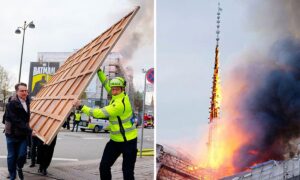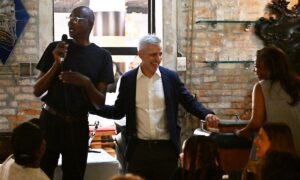
In The Left Hand of Darkness, the science-fiction pioneer Ursula K. Le Guin writes: “The only thing that makes life possible is permanent, intolerable uncertainty: not knowing what comes next.” Le Guin’s words find visual footing in the wry, genre-bending work of Rita McBride, whose structural marvels have asked big, booming questions about human futurity over the span of her 30-year career. McBride’s large-scale, interdisciplinary sculptures distil the optimism of alternative methodologies into architectural gestures, drawing on geometry and bodily interception to sketch the sublime in three dimensions. In 2023, the curator Connie Butler brought Particulates (2017)—a hyperboloid installation of swirling, money-green lasers—to the Hammer Museum’s new space in a former City National Bank building on Wilshire Boulevard in Westwood.Originally commissioned for the Dia Art Foundation, Particulates (2017) grew from McBride’s Portal show at the Liverpool Biennial in 2016 Photo: Joshua WhiteParticulates, originally commissioned for Dia Art Foundation, has lived many lives. Its hyperboloid shape, which McBride describes as mathematically “perfect” for load bearing, looms large in the artist’s practice; her best-known public work, 2011’s towering 170ft sculpture Mae West, memorialises its formal proportions in Munich, Germany. Particulates grew out of McBride’s Portal (2016), a laser installation designed for the Liverpool Biennial as a “wormhole” escape from the long shadow that Thatcherian austerity cast over the city. Particulates builds further upon that speculative sense of wonder; composed of high-intensity laser beams, water molecules and dust particles dancing mid-air, its third iteration at the Hammer both reflects and charges its abandoned industrial environment with the ambient force of a film set, glowing from the mouth of a dark, 1960s bank vault as it materialises before the viewer’s eyes. Visible at all hours from the tinted windows of its basement enclosure, the multi-helix form redefines its former commercial space through an eerie ephemerality; time may not have stopped but, for the viewer, it has certainly changed.The Art Newspaper:How do the former-bank environs of the Hammer change or further charge the meanings and interpretations of Particulates?Rita McBride:Like all good things, there was so much of it I couldn’t predict. Particulates was phased in with the renovation of the museum, so the Hammer had the decision-making process, but I responded with pleasure. I was thinking about it as a corporate ruin: what things were important to keep and what things were important to get away from as they went forward with their renovations. Particulates can exist anywhere—any size, any scale—so it can take on hermetic situations or, like this one, open to the street and to a more narrative space than at Dia or in Liverpool. But it’s amazing how this version is so strong. It lives in a real place, and that’s been interesting, because it always occupied an anonymous space before. It’s amazing; people are responding to that a lot more than I ever imagined.What is the work’s relationship with, and the audience’s experience of, time?One of the things I love about it is that it is durational but there is no assumed beginning or end; it portrays time as it’s happening. That’s what’s so mesmerising about standing or sitting in the space and watching the particulates hit the laser beams. They move in these waves, which are never the same, have different effects and are affected by who’s in the room, how air is moving through the room and all these other atmospheric conditions. I somehow calibrate time and show time, make time visible in a non-linear way, even though there are these giant lines that are endless. That’s what I love about lasers; I can draw through space, and it’s infinite. That kind of expansive thinking is what excites me about that piece. Time travel was the emphasis at the beginning, trying to get an escape route available, even imaginarily. Because you can also watch the street go by and the buses stop and people go by, there’s another element. The traffic’s going the opposite way of a lot of the movement and duration in the piece itself, so it has a simultaneous embodiment of time. There’s portraiture to it, too. It’s somehow a continuum of particles and movements. It’s not like linear time.The current iteration of Particulates is in the Hammer Museum’s new space in a former bank Photo: Joshua WhiteWhat role does science fiction play in your practice?Science fiction is totally optimistic, a kind of realistic optimism that I can live with and dream in. It’s not so fantasy oriented. Right now I’m reading Sarah Pinsker’s short stories; they are so precise and damning that she can critically talk about today while imagining a future circumstance. I find the efficiency of it both incredible and believable. The plausibility of sci-fi informs my enthusiasm and motivation for imagining a world that’s changing, that evolves, adapts—and always for the better, of course. Sci-fi is full of rich imagery and constructions which can be transportable or hint at change or perspective shifts that can allow us to think more critically about where we are now and where we want to be. Plausible change—that’s what I like about it.What is it about the hyperboloid that inspires you to keep returning to it?The original hyperboloid is a geometrical form that is very, very stable for building. I started to use it because it’s this simple, beautiful geometry. I love geometry. I like the purity of it. And as I’m always making sculpture, I’m doing things standing or hitting gravity—not with lasers, thankfully. I also love that there are two rotating circles that give it structure and strength, that it’s infinitely strong and variable in dimension. The possibilities are quite endless with that structure, that geometry.As an artist engaged in social architecture in public spaces, and with a deep investment in optimism, how were you and your practice impacted by Covid-19?Covid had a huge impact. I’ve not interpreted it in a very concrete way, but it changed the speed with which I’m thinking, operating, building, making and doing. I like space more than I like anything, and during Covid my public space was limited. What’s beautiful about Particulates is that it is so cinematographic. It doesn’t have to exist so much in reality. I’m realising now that it is mainly a place for people to take selfies. Normally, I’d be like, “Oh, don’t take selfies, just be in here looking,” but during Covid, this whole relationship with image and being shifted for me. It’s a great example of how easily that can happen.• Rita McBride: Particulates, until 3 March, Hammer Museum, Los Angeles


























